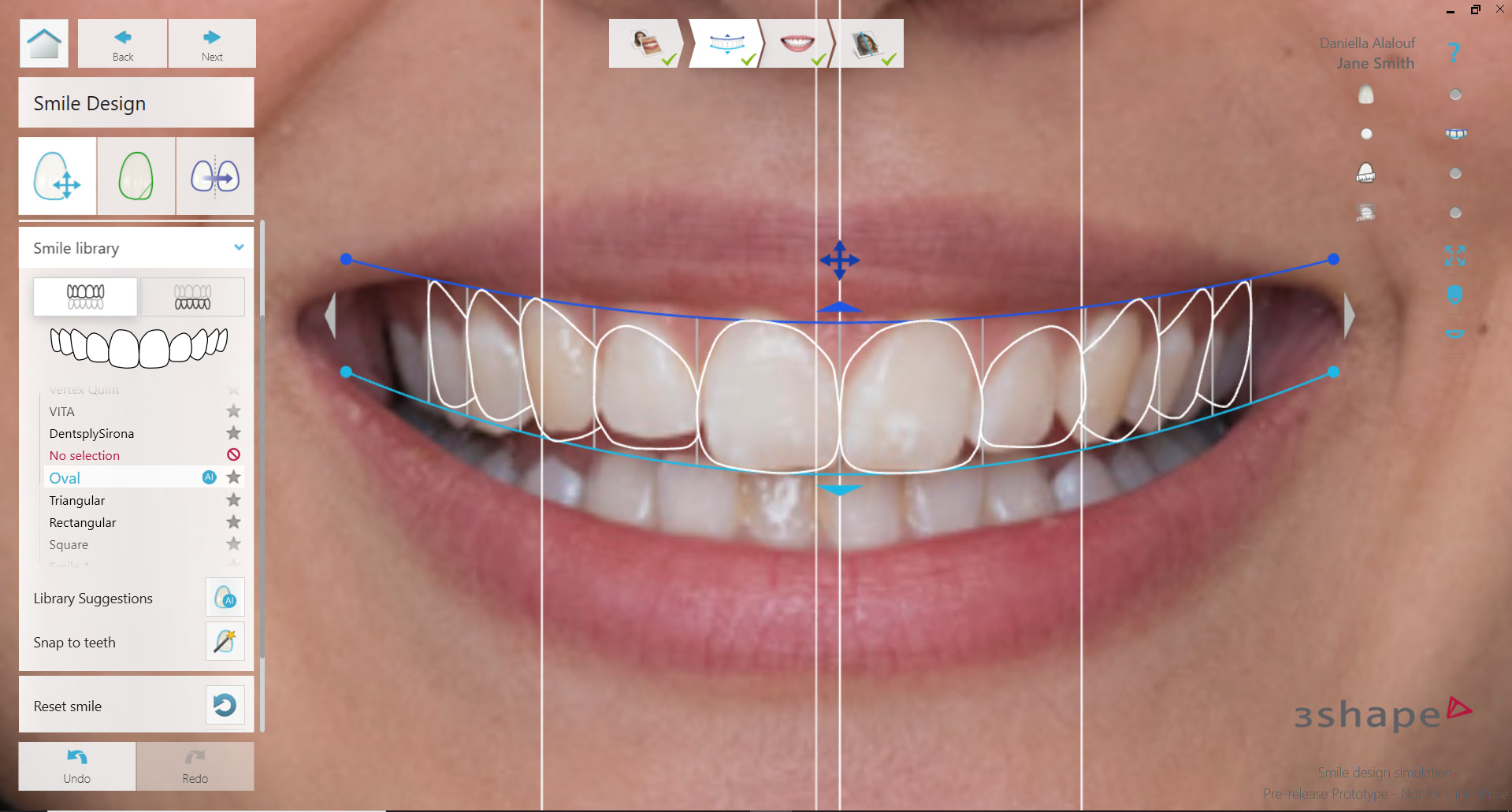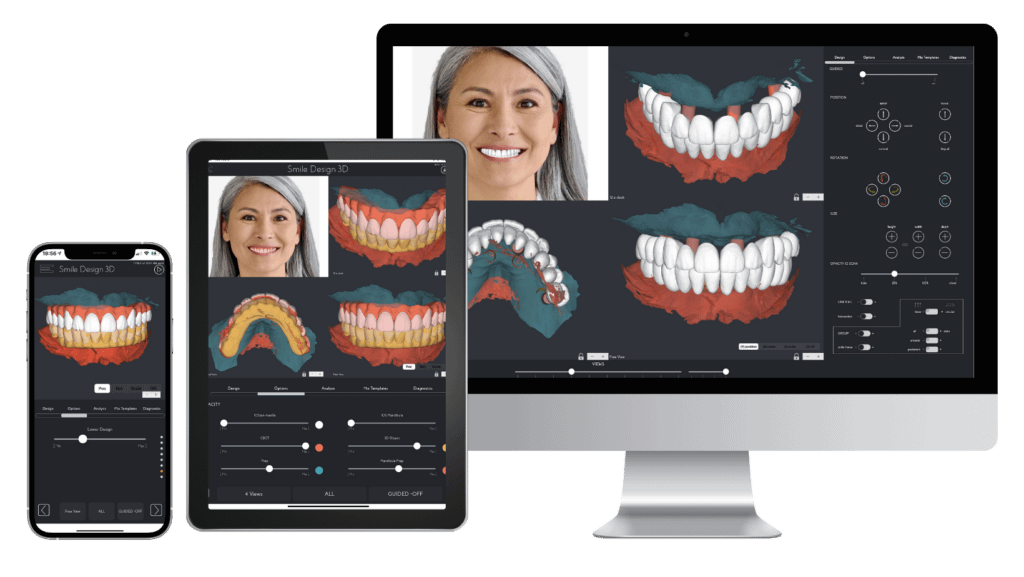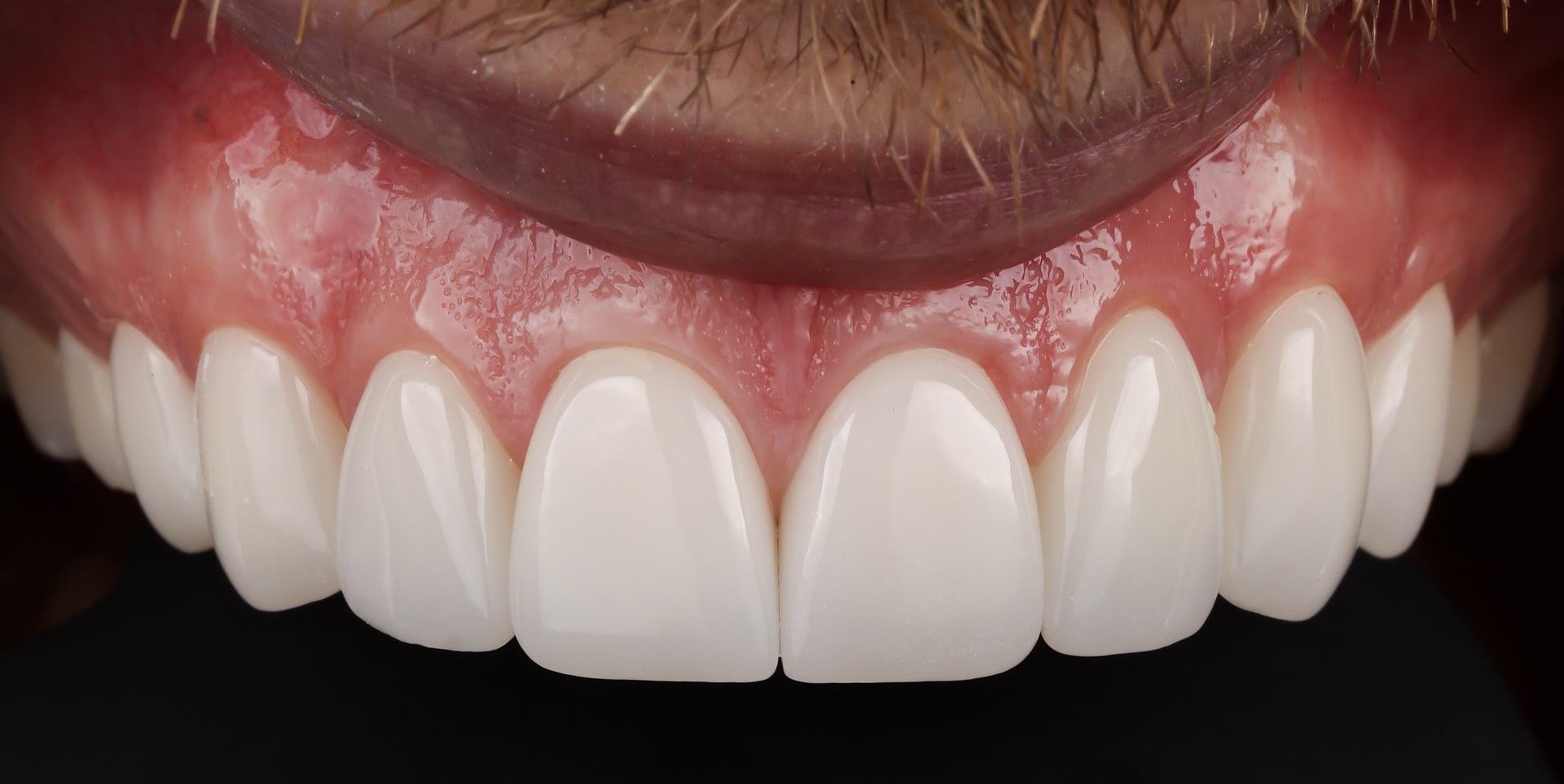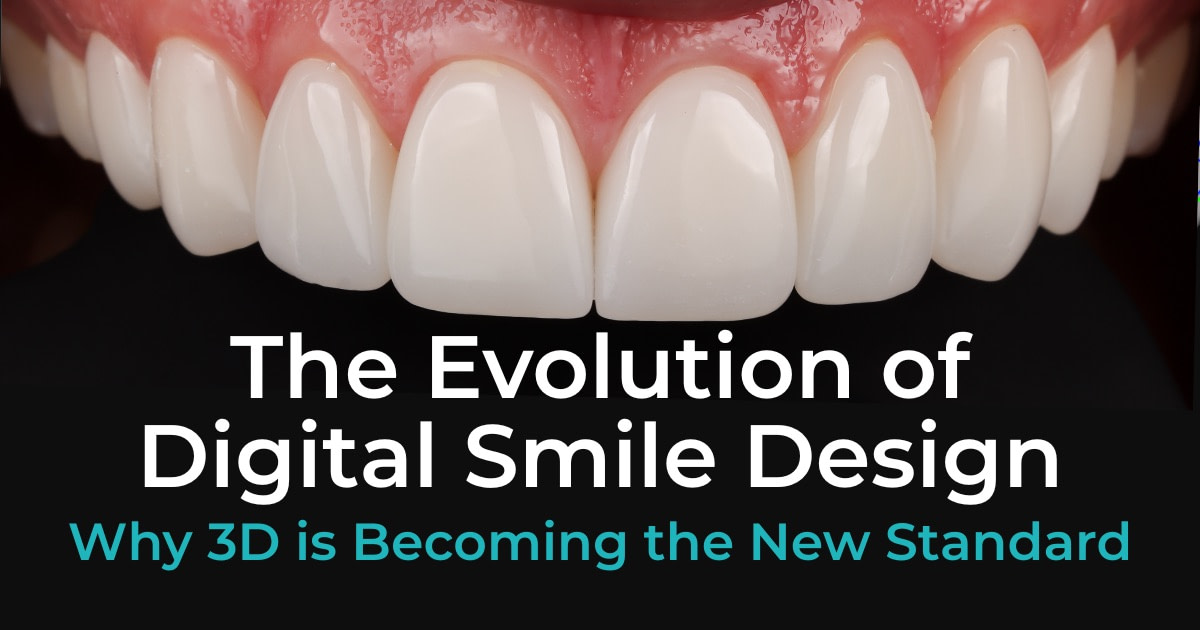The landscape of aesthetic dentistry has experienced a fundamental shift that many practitioners are still catching up with. While 2D digital smile design, popularised by the talented Dr. Christian Coachman, has served as our gateway into visual treatment planning for over a decade, the limitations of working in a flat, two-dimensional world are becoming increasingly apparent as patient expectations rise and clinical precision demands grow.
The question isn't whether 3D digital smile design represents the future - it's whether practices that continue relying solely on 2D workflows will be able to meet the evolving standards of modern aesthetic dentistry.
The Foundation: Understanding 2D Smile Design
2D digital smile design fundamentally changed how we communicate with patients about aesthetic treatments. By overlaying proposed tooth shapes onto facial photographs using mathematical guidelines like the Golden Proportion or RED Proportion, we could finally show patients a visual representation of their potential new smile before any irreversible treatment began.
This approach revolutionized case acceptance rates and gave patients confidence in aesthetic procedures. The ability to adjust tooth length, width, and proportions on a photograph provided an invaluable communication tool that bridges the gap between clinical expertise and patient understanding. It also played an important role in improving clinic-lab communication.
However, as our understanding of facial esthetics and digital capabilities has evolved, the inherent limitations of 2D planning have become more pronounced.

The Reality Check: 2D Limitations in Modern Practice
Inaccurate Arch Representation
One of the most significant challenges with 2D smile design lies in its inability to accurately represent the true curvature of the maxillary arch. When we work from a single frontal photograph, we're essentially projecting a curved dental arch onto a flat plane. This works reasonably well for the anterior region visible in a typical smile, but falls short when planning comprehensive cases involving posterior teeth.
The mathematical guidelines that work perfectly on paper like Golden Proportion ratios and symmetrical measurements, don't always translate to the three-dimensional reality of oral anatomy. The result? Designs that look beautiful on screen but may prove challenging to execute clinically.
Surface-Only Visualization Constraints
Traditional 2D approaches limit our visualization to what's visible in the photograph - primarily the facial surfaces of anterior teeth and minimal posterior visibility. This surface-only perspective creates a few challenges:
Incomplete treatment planning: We can't visualize lingual contours, embrasure spaces, or the transition from anterior to posterior teeth
Limited prosthetic guidance: Lab technicians receive insufficient information about the three-dimensional tooth forms needed
Occlusal considerations: Functional aspects of the new smile remain largely unaddressed in the 2D planning phase
Translation Challenges to Clinical Reality
Perhaps most frustrating for practitioners is the difficulty in translating 2D designs into accurate clinical outcomes and wax-ups. The leap from a beautiful 2D design to restorations or final prosthetics often involves some guesswork and multiple adjustments.
This translation gap not only increases chair time and laboratory costs but can also lead to patient disappointment when the final result doesn't perfectly match their expectations set by the 2D visualization.
The 3D Revolution: Beyond Visualization to Precision
The emergence of sophisticated 3D digital smile design platforms represents more than just a technological upgrade, it's a fundamental shift toward clinically integrated treatment planning.

True Anatomical Integration
Modern 3D smile design workflows integrate multiple data sources to create comprehensive treatment plans:
Intraoral scan data provides precise dental anatomy and existing restorations
Facial photography and scanning captures soft tissue relationships and facial proportions e.g Rayface and Qlone app
Functional bite analysis incorporates occlusal relationships and jaw movement patterns e.g ModJaw
CBCT data when needed adds skeletal and root position information
This multi-modal approach creates treatment plans that account for the patient's complete oral and facial anatomy rather than relying on mathematical averages or ideal proportions.
Predictable Clinical Translation
One of the most significant advantages of 3D workflows is the ability to create physical mockups that accurately represent the digital design. Through 3D printed wax-ups, provisional restorations, or preparation guides, the translation from digital plan to clinical reality becomes far more predictable.
This predictability extends to:
Preparation depth verification: Ensuring adequate reduction without over-preparation
Provisional accuracy: Creating temporaries that precisely match the approved design
Laboratory communication: Providing technicians with complete three-dimensional guidance
Enhanced Patient Communication
While 2D designs excel at showing patients their potential new smile, 3D visualization takes communication to another level. Patients can have their digital smile design transferred to the mouth and see their proposed treatment from multiple angles, understand the relationship between their new teeth and facial features, and gain confidence in complex treatment plans.
The ability to show patients exactly how their new smile will look and function, not just from one frontal view, significantly improves treatment acceptance and reduces post-treatment adjustments.
Clinical Implications: When 3D Makes the Difference

Complex Esthetic Cases
For comprehensive smile makeovers involving multiple teeth, the advantages of 3D planning become immediately apparent. These cases require careful consideration of:
- Tooth position and angulation changes
- Gingival architecture modifications
- Occlusal plane adjustments
- Posterior esthetics and function
2D planning simply cannot address these multi-dimensional considerations with the precision required for predictable outcomes.
Interdisciplinary Treatment Planning
Modern esthetic cases often involve multiple disciplines, orthodontics, periodontics, oral surgery, and restorative dentistry. 3D digital models provide a common language and reference point for all team members, improving communication and coordination throughout treatment.
Minimally Invasive Approaches
The precision offered by 3D planning enables more conservative treatment approaches. When we can accurately predict the final result and plan exact preparation depths, we can often preserve more natural tooth structure while still achieving optimal esthetic outcomes.
Implementation Considerations for Practices
Technology Integration
Transitioning to 3D smile design workflows requires more than just software. It demands integration with existing digital systems:
- Intraoral scanning capabilities become essential rather than optional
- Facial scanning or systematic photography protocols need to be established
- 3D printing or external fabrication for physical mockups
- Staff training on new software and workflow procedures
Investment vs. Return Analysis
While 3D smile design systems represent a significant investment, the potential returns include:
- Improved case acceptance through better patient communication
- Reduced revision appointments due to more predictable outcomes
- Enhanced practice reputation for advanced esthetic capabilities
- Increased treatment complexity and corresponding fee potential
Learning Curve Management
The transition from 2D to 3D workflows involves a learning curve for both clinical and administrative staff. Successful implementation requires:
- System-specific training rather than generic smile design education
- Workflow refinement based on initial case experiences
- Patient communication adaptation to new visualization capabilities
The Broader Digital Dentistry Context
The evolution from 2D to 3D smile design reflects broader trends in digital dentistry toward increased precision, integration, and predictability. This transition aligns with other advancing technologies:
- AI-powered treatment planning that can suggest optimal tooth positions based on facial analysis
- Automated design suggestions that reduce planning time while maintaining quality
- Cloud-based collaboration enabling real-time communication with laboratories and specialists
- Virtual reality visualization for even more immersive patient communication
Looking Forward: The Future of Smile Design
As we move forward, the question for practices isn't whether to adopt 3D smile design workflows but how quickly they can effectively integrate these capabilities. The gap between practices offering 2D visualization and those providing comprehensive 3D planning will likely continue widening.
Several factors will drive this evolution, listed below.
Competitive Differentiation
Practices offering advanced 3D smile design capabilities will have significant advantages in attracting and retaining esthetic cases, particularly as patients become more aware of these technologies.
Clinical Liability Considerations
The improved predictability offered by 3D planning may become a standard of care expectation, particularly for complex esthetic cases where patient satisfaction is paramount.
Rising Patient Expectations
Patients increasingly expect to see detailed visualizations of their proposed treatments. As 3D smile design becomes more common, patient expectations will naturally evolve to expect this level of detail and precision.
Conclusion: Precision Meets Artistry
The evolution from 2D to 3D digital smile design represents more than technological advancement - it embodies our profession's commitment to combining artistic vision with scientific precision. While 2D smile design will always remain valuable for patient communication and simple planning scenarios, the comprehensive capabilities offered by 3D workflows are becoming increasingly necessary for delivering the predictable, high-quality esthetic outcomes that modern patients expect.
The practices that successfully navigate this transition will find themselves better equipped to handle complex esthetic cases, communicate effectively with patients and laboratory partners, and deliver consistently excellent results. Those that delay this evolution may find themselves at a significant disadvantage as digital dentistry continues its rapid advancement.
The question isn't whether 3D smile design represents better dentistry - the clinical evidence increasingly supports this conclusion. The question is whether individual practices are ready to embrace the learning curve, investment, and workflow changes necessary to deliver this enhanced level of care.
As our profession continues evolving toward greater precision and predictability, 3D digital smile design stands as a cornerstone technology that bridges the gap between artistic vision and clinical reality. The time for considering this transition is now - before it becomes not just an advantage, but a necessity.

